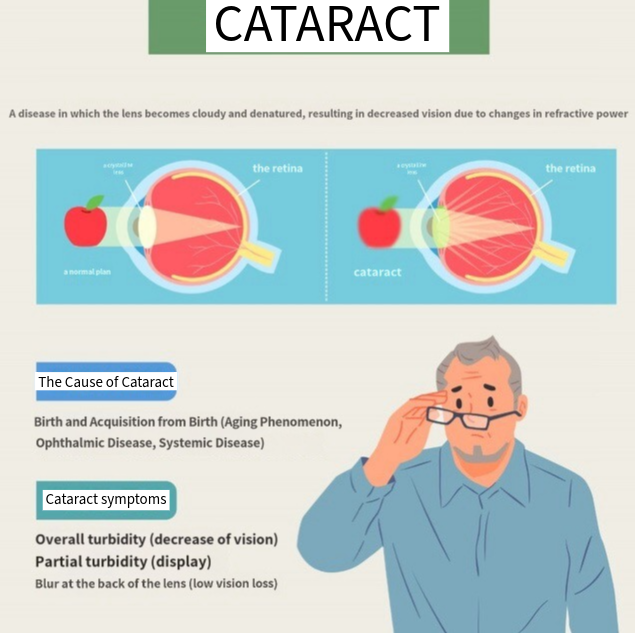
Cataract is a representative senile eye disease that occurs due to the aging of the lens. It is generally observed in people in their 60s and older, but cataract patients are getting younger recently. According to the Health Insurance Review and Assessment Service, the number of patients in their 40s who underwent cataract surgery as of 2020 was 98,834, an increase of about 2.7 times from 33,910 in 2010. Every June is the “Caucoma Awareness Month” established by the American Real Name Prevention Association to announce the risk of cataracts that gradually lose vision over a long period of time. What is cataract and how do you deal with it? What is cataract? = In our eyes, there is a lens that acts as a lens for a camera. Cataract refers to a state in which the lens is blurred and becomes cloudy. It is characterized by the degeneration of the protein of the transparent lens, showing turbidity such as white or yellow, and in severe cases brown. If the symptoms are not severe, it is not easy to check the degeneration with the naked eye, so accurate diagnosis and action are required. In general, when cataract occurs, light cannot enter the retina clearly, resulting in decreased vision that looks blurry or blurred. However, most of the symptoms progress slowly over a long period of time, so it is often not recognized.In particular, there are many people who do not recognize it until the disease progresses because it is rarely accompanied by pain in the eyeball.

Professor of Ophthalmology at St. Mary’s Hospital explained, “Caucoma is cited as the main cause of aging and abnormal denaturation of protein due to diabetes, but it can also be caused by trauma, heredity, or drugs such as steroids.” “Catars that significantly affect vision can occur even in people in their 30s and 40s due to diabetes or atopic diseases,” he said. “Even in the younger age group, periodic ophthalmological checkups are needed if they have diabetes.”
How to deal with cataracts? = There are two types of cataracts: conservative and surgical. The conservative method is to put eye drops on the eyes that delay the progression of cataracts by checking the progression of cataracts and vision loss. It is mainly used when cataracts are detected early on. However, it is not possible to return the already advanced turbidity of the lens to the previous transparent state, and even if eye drops are used, the progression of cataracts cannot be completely prevented. If cataracts have a significant impact on vision loss, consider surgery. In general, if the patient feels uncomfortable in his or her daily life, he or she decides to operate. Cataract surgery is performed by performing ultrasonic emulsification aspiration to remove the lens that has developed cataracts and inserting artificial lens of a suitable frequency into an empty lens bag. Recently, astigmatism artificial lens insertion is performed to improve the vision (visibility that comes out without glasses) as much as possible, or multifocal artificial lens insertion is performed to improve presbyopia.

“In order to select the most suitable surgical method or artificial lens for the patient, the patient’s whole body disease, age, and even life pattern and occupation should be identified through sufficient interviews and interviews before surgery, along with corneal topography, refraction test, and fundus test,” he stressed.The degree of vision recovery after surgery is determined by eye conditions such as cornea, vitreous body, and reticulum. Symptoms due to turbidity of the lens can be improved through surgery, but vision impairment due to weak vision, high myopia, and other optic nerve diseases is difficult to recover from cataract surgery. He added, “Over a certain age, cataracts should be detected and managed early through active early examination.” However, we should manage our eyes ourselves, reduce eye fatigue, and effectively manage eye fatigue with thermal massages and steam.

▲ MalangTank
▲ solutioner
▲ Jeon Ui Jin
▲ softtank2023@naver.com
▲+82 10-7520-6044
SALLY LEE
US ASIA JOURNAL



